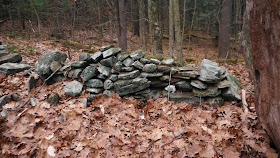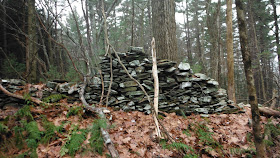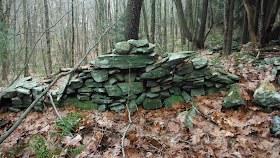(Continuing from previous post:)
I couldn’t follow
the stone rows I wanted to because of the tree work – well, I suppose I could
have really, I just didn’t want to. So, I scooted across the eastern parcel
until I came to another gate in another stone wall, the parallel boundary of the
parcel:
Above: the upper (south) side of the gate, the most
noticeable feature, a large rectangular boulder, a featured I’ve observed in
other gates locally – and compared to similar “head stones” of serpentine
petroforms in Manitoba. Below: the lower (north) side of the gateway with a
large round boulder…
And here again, there was the slight angle of a suspected
serpent head looking out at the person entering the space, that Uktena or
Strong Looker as a sort of protector of that space, knowing the thoughts of the
person about to enter, a suggestion of eyes in the blocky stone seen above. I
followed southward, looking to see (observe) if that same undulation in height
would be present here too…Above: running eastward, down into a sea of ferns: below: extending south toward modern paths, still in use as possibly wood roads or maintenance access trails or something like that, I’m not sure…
Above: looking north at the south-side/outside of the corner, dipping down to the messy gateway. Below: the same corner, looking west, from the “inside.”
I’d call the undulations here “sharper,” for lack of a better
word. Perhaps it wasn't exactly like this – maybe someone wanted those flat capstone-like slabs for something else,
one reason to explain this away – or why they went away – if they were indeed
once there:
One or two close
ups and details, a fifth section to come in a future post:
(Photo from 2014:)
(Below: a little more than just a little zoomorphic:)























No comments:
Post a Comment